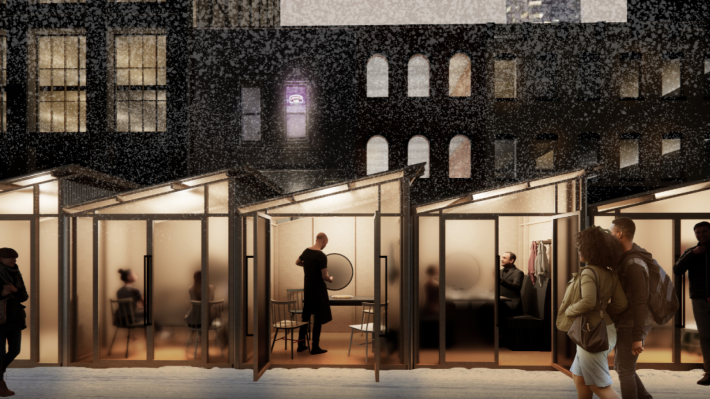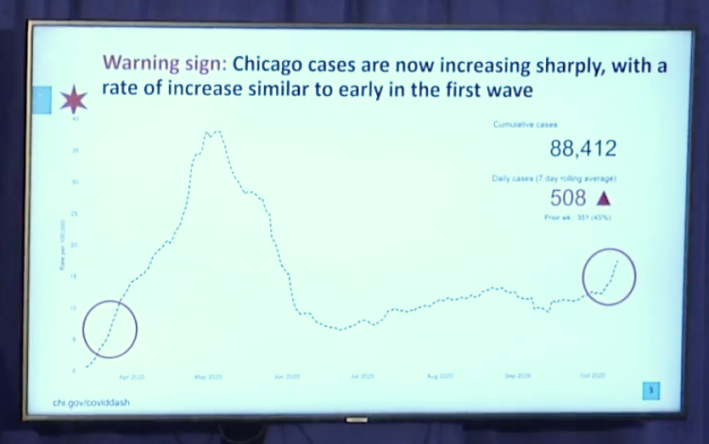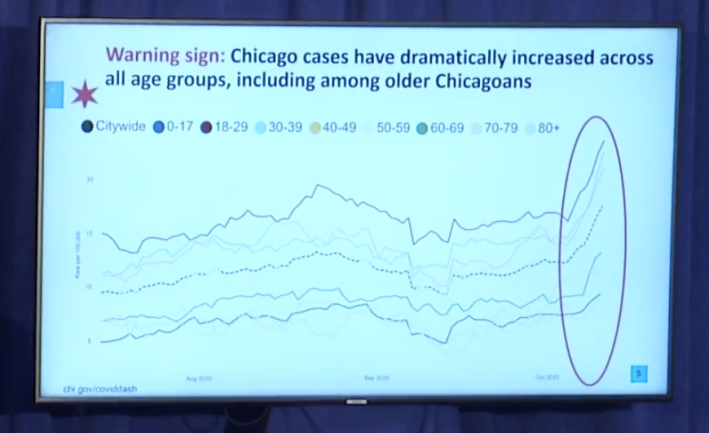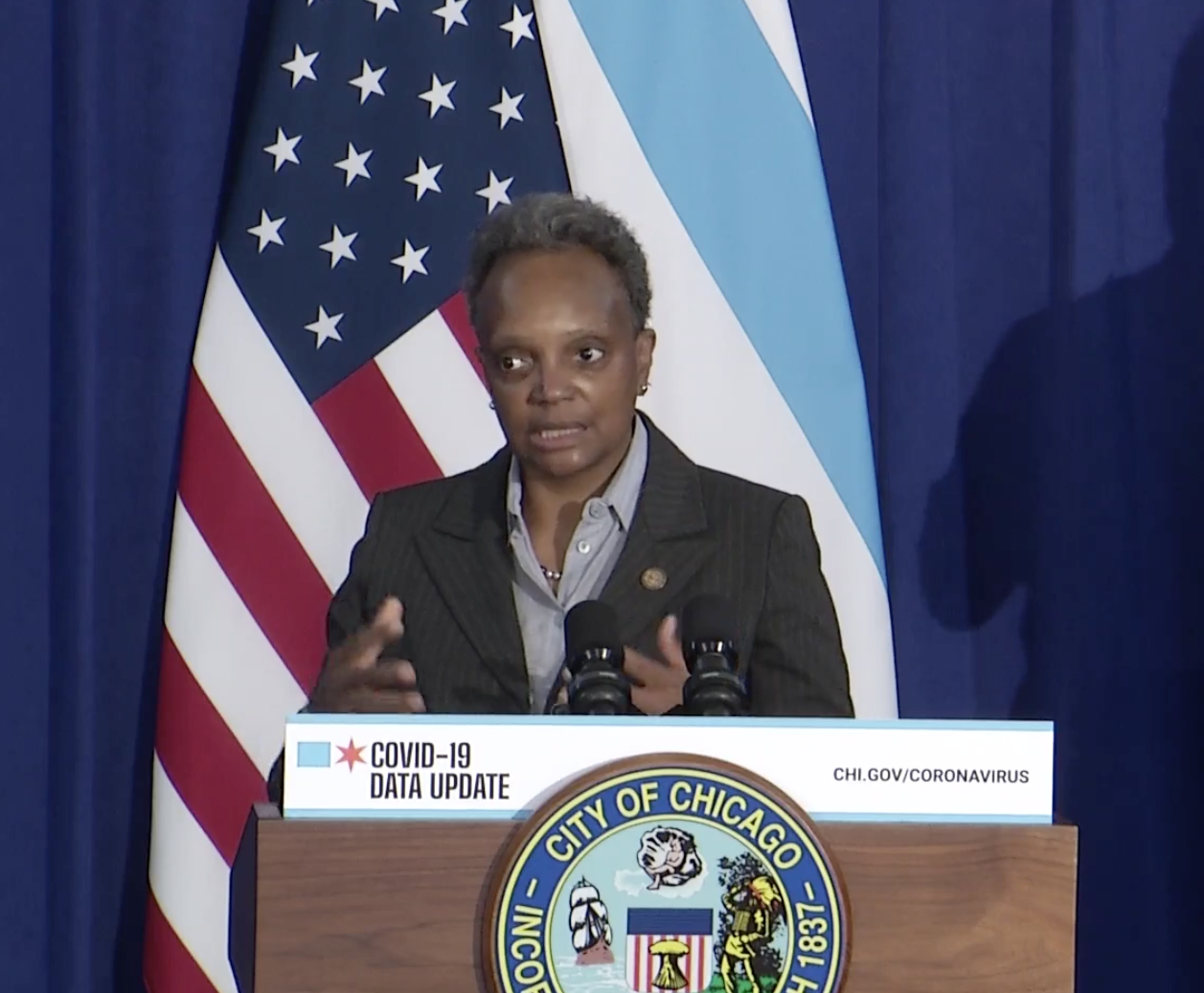Infectious disease experts generally agree that it's best to avoid hanging out in indoor public spaces for non-essential purposes during the COVID-19 airborne respiratory pandemic, especially restaurants and bars, where it's impossible for customers to remain masked. This summer the city of Chicago did a good job of facilitating safer outdoor dining and drinking by easing regulations on sidewalk cafes, and pedestrianizing dozens of streets to make room for socially-distanced seating.
Mayor Lori Lightfoot also launched a contest to brainstorm ideas for enabling COVID-safe outdoor service through the winter. Two of the winning entries involved repurposing curbside parking spaces to create individual dining or drinking spaces for small groups of patrons.

Hopefully many Chicago restaurants and bars will get creative about offering safe socially-distanced options for customers this winter. But as it stands, that's not an option for all local dining and drinking venues.
In countries like New Zealand that have had success fighting COVID-19, hospitality workers and business owners received sufficient payments from the government to ease the pain while their establishments were shut down as a safety measure. But in the United States, many employees and entrepreneurs are having to make an impossible choice between increasing viral exposure risks for themselves, their customers, and the general public by providing indoor service, and possible financial ruin.
Coronavirus cases were down in Chicago this summer, when indoor service was banned at bars without kitchens, and restaurants were limited to 25 percent of their normal indoor capacity. On September 28, Lightfoot eased those restrictions, allowing indoor bar service again, and raising indoor restaurant service capacity to 40 percent.
While so far Illinois has been spared the recent dramatic spikes in cases that neighboring states like Wisconsin and Indiana, which arguably reopened too soon, COVID is on the rise in Chicago again. For example, earlier this month 43rd Ward alderman Michele Smith reported that the retail-dense River North and Lincoln Park communities saw a spike in September, with 428 people diagnosed with COVID, more than in May and higher than the city average. "We are losing ground in our fight against COVID," she said.
At a press conference this morning, Lightfoot and Chicago Department of Public Health commissioner Allison Arwady noted that in the past week our city has seen a troubling growth in infections, with the rate of increase similar to what our city saw during the first wave. To slow the spread, they asked residents to refrain from spending time with non-household members at their homes for non-essential purposes, including dinner parties, card games, and backyard hangouts. "I'm here to tell you that that has to stop," Lightfoot said. Arwady added, "Do not invite people into your home for non-essential reasons, period."

However, Lightfoot and Arwady said little, if anything, about the significant risk difference between socializing indoors versus outdoors. And their zero-tolerance message about spending time at your home with people you don't live with seems to conflict with the administration's recent relaxation of the indoor dining and drinking rules.
During the Q & A section of the presser, I asked Lightfoot whether, in light of the advice from experts that hanging out in indoor public spaces should be avoided, and the recent spike in cases in retail-rich parts of town, the administration would consider restricting indoor service again. I also asked whether the mayor would consider coming up with another way to help hospitality workers and business owners, such as stipends for keeping businesses closed, or grants to facilitate outdoor service. Here's what Lightfoot had to say:
There's a lot packed into that question. Let me try to address it, and I'm going to invited Dr. Arwady [to address it.] I mentioned in my initial comments that I get a report every day from Dr. Arwady and her team, and then we do a deeper dive once a week in looking at the data. And we started to see this uptick.
The question I always ask is, what are you seeing in the numbers, meaning, is there any particular segment, any particular geography, any particular demographic? Because what we want to do is try to be as surgical as possible with targeted interventions. And unfortunately, as I think Dr. Arwady's presentation makes plain, we're not seeing this as a source from one particular area.

So going to the question of bars and restaurants, obviously if we felt like that was the source, that's easy in the sense of targeted intervention, certainly not easy in terms of the impact on those business owners. But obviously we're looking at everything; we have to. We're seeing this across the board as I said. Every demographic, every area of the city. It's not going to be easy for us to do a targeted intervention. But we certainly are going to be looking at a range of different options.
I don't think there is a cause-and-effect, and we looked at that. The question suggests that loosing the restrictions on bars and restaurants caused this uptick in cases. That is not what we're seeing in the data at all. I think it is what we thought, which is we feared and were signaling even back in March, the potential for a second wave. It's cold, it's flu season, we're going indoors, and so the maximum environment for the virus to thrive, we're now in that season in our city.
And, again if we were seeing it in one location or another, we could address and mitigate against that, but we're just seeing it across the board, as is happening really across the country and and across the world. But we are looking at a number of different tools that are available.
But what today is about is a couple of things. One, sounding the alarm, making sure that people understand that we are absolutely in the second surge. But also reminding folks of what tools they personally have at their disposal to do what is necessary to try to address and solve this problem. We can't let down [our guard], and people have let down. They've relaxed. They're tired of being home. They're tired of streaming everything that they possibly can on Netflix or Prime Video. They're tired of not being in communion, if you will, with their friends and family, and we all get that.
But we've got to go back to what served us well before, which is social distancing, mask wearing, limiting our contact with others as much as we possibly can. And I want to place some emphasis on understanding the challenge of essential workers and essential functions, including education.
And here's Arwady's response:
I would just add a couple things. One is that we actually continue to have stricter restrictions in place here in Chicago than are required at the state level. And I think we've had a very good and robust interaction and engagement with industry partners across the board -- that would include the restaurants and bars -- where they have by and large done a very good job of following the public health requirements that are not in place. Where we have seen spaces where that has not been true, [the Chicago Department of] Business Affairs and Consumer Protection has worked hard to pull that into place.
But, as the mayor said, where we are seeing spread is not the spaces that we regulate as a city by and large. And where we make decisions about limiting gatherings, limiting the number of people who can come together, the fact that, for example, in restaurants we said that you can only keep it to six people within a restaurant table. That is based on the risk of COVID, when people are getting together without masks.
And I am always conscious of balancing the economic and the health risks. Of course, as the public health department, I come down first and foremost on doing what needs to be done to help protect the health of the city. But just as we've seen in schools in schools where the guidelines have broadly been followed, they've not been major sources of spread. Just as we've seen in transit, with a lot of careful attention to the masks and the distancing, we've not seen those major sources of spread.
The surgical approach here, unfortunately, is the one where we do not regulate. It is the one encouraging people within their own homes and in their gatherings to really double down.
Lightfoot and Arwady's comments didn't address why dining or drinking in a group of up to six non-household members inside a restaurant or bar is currently allowed, while they're cautioning people not to do that inside their own homes, or even in their own backyards. That question is particularly vexxing when you consider that indoors restaurant and bar patrons are breathing the same air as other tables of customers and employees, further increasing their risk.
If the city's finding truly are that dining and drinking inside restaurants and bars in groups of up to six is reasonably safe, it should fine-tune its message on private gatherings to make it clear that having a few friends over for dinner inside your house, let alone in your back yard, isn't a death-wish either.
And if that's not actually the case, rather than waiting for the infection and fatality figures to get worse before they ban indoor restaurant and bar service again, it would be best if Lightfoot took action now. If so, she should simultaneously provide more help to the hospitality industry in terms of compensation for lost wages and revenue and/or help with providing safer outdoor service.



